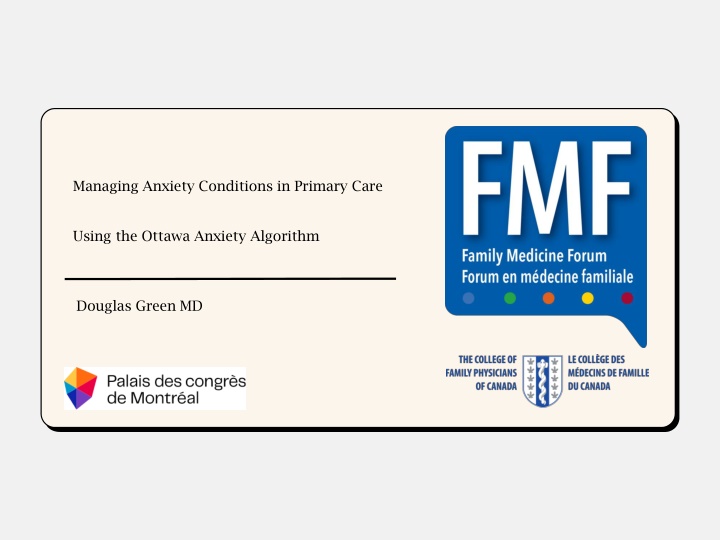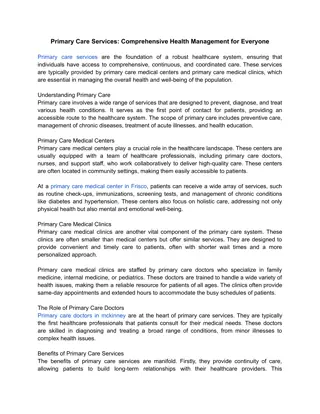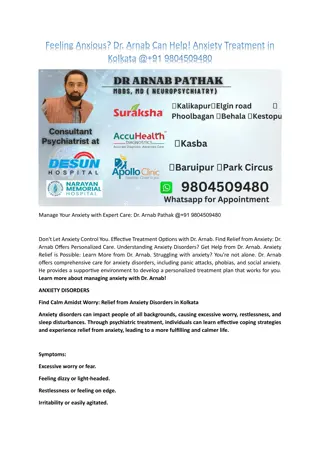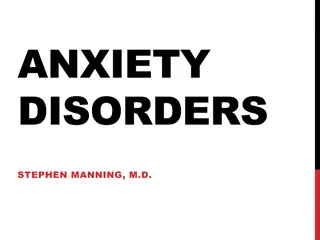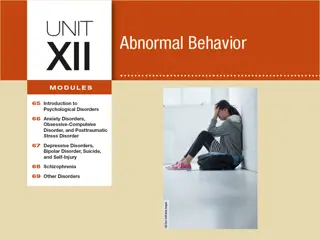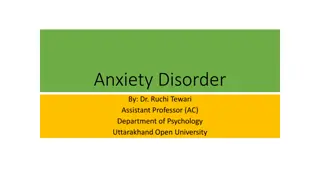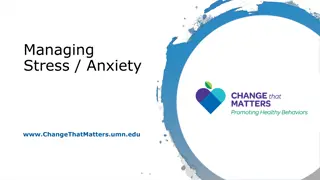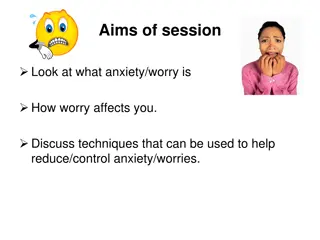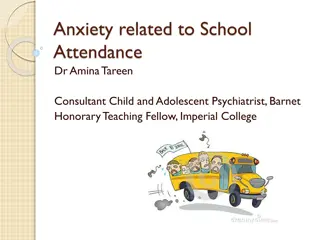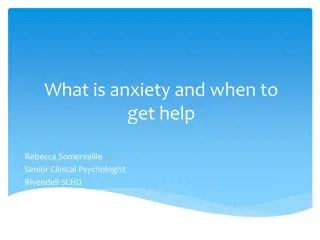Managing Anxiety Conditions in Primary Care Using the Ottawa Anxiety Algorithm
Anxiety disorders are prevalent and often underrecognized in primary care settings, leading to significant burden and impact on patients' lives. This presentation by Dr. Douglas Green focuses on discussing the prevalence, types, concurrent disorders, and management of anxiety using the Ottawa Anxiety Algorithm in primary care. The program aims to improve the recognition and treatment of anxiety disorders to enhance patient outcomes and quality of care.
Download Presentation

Please find below an Image/Link to download the presentation.
The content on the website is provided AS IS for your information and personal use only. It may not be sold, licensed, or shared on other websites without obtaining consent from the author.If you encounter any issues during the download, it is possible that the publisher has removed the file from their server.
You are allowed to download the files provided on this website for personal or commercial use, subject to the condition that they are used lawfully. All files are the property of their respective owners.
The content on the website is provided AS IS for your information and personal use only. It may not be sold, licensed, or shared on other websites without obtaining consent from the author.
E N D
Presentation Transcript
Managing Anxiety Conditions in Primary Care Using the Ottawa Anxiety Algorithm Douglas Green MD
Presenter Disclosure Presenter: Douglas Green Relationships with financial sponsors: Any direct financial relationships, including receipt of honoraria: Not applicable Membership on advisory boards or speakers bureaus: Not applicable Patents for drugs or devices: Not applicable Other: Not applicable
This program has received financial support from [organization name] in the form of Not applicable Disclosure of Financial Support This program has received in-kind support from [organization name] in the form of Not applicable Potential for conflict(s) of interest: Not applicable
LEARNING OBJECTIVES 1. Discuss prevalence and presentation of anxiety in primary care 2. Define and differentiate the most common types of anxiety disorders 3. Describe the common concurrent disorders found in patients with anxiety disorders 4. Describe the mainstay of pharmaceutical management for the anxiety 5. Review non-medication treatment for anxiety 6. Demonstrate how to use the Ottawa Anxiety Algorithm to diagnose and manage anxiety in primary care using a case
WHO I AM Psychiatrist working with The Ottawa Hospital Shared Mental Health team for the last 12 years Multidisciplinary team that provides to 2 academic family health teams (serving over 30,000 patients): Diagnostic and treatment suggestions Group and individual CBT and DBT Teaching of family health team staff and residents Main diagnoses we treat are anxiety and depression
INTRODUCTION Anxiety disorders are the most common psychiatric disorders (greater than depression!) Estimated annual prevalence of 18 % Higher prevalence amongst women Under recognized in primary care About 40% of patients go untreated
BURDEN OF ANXIETY DISORDERS Associated with: Substantial functional impairment Greater use of health care services and costs Decreased work productivity Increased risk of suicide Burden increases with severity of anxiety and number of comorbid anxiety and other disorders
IMPACT OF ANXIETY DISORDERS Anxiety disorders impose an economic burden comparable with the costs of depression, with 54% of the cost expended for non-psychiatric medical care of physical complaints Incur two-fold the primary care costs and overall health care costs compared with those without anxiety
IMPACT OF ANXIETY DISORDERS Significantly associated with: thyroid disease respiratory disease GI disease arthritis migraine headaches and allergic conditions Comorbidity with physical conditions is associated with poor quality of life and disability
COMORBIDITY Although directionality of comorbidity varies, a primary anxiety disorder often contributes to secondary depression or substance abuse Much comorbidity exists with depression, substance abuse, and somatization At least 30% and possibly up to 2/3rds of patients with one anxiety disorders may have another anxiety disorder
RECOGNITION OF ANXIETY DISORDERS IN PRIMARY CARE Only about one third of patients with an anxiety disorder treated in primary care receive appropriate treatment One of the reasons is under recognition of anxiety disorders
WHY IS ANXIETY UNDER DIAGNOSED IN PRIMARY CARE?
POSSIBLE REASONS FOR UNDER DIAGNOSIS Patient unwillingness or inability to discuss their anxiety problems Limited knowledge of some primary care provider about anxiety disorders Time pressures of health care providers with perception that not enough time to inquire about emotional problems May present with somatic symptoms or sleep disturbance
BARRIERS TO TREATMENT An even greater barrier may be the nonunitary nature of anxiety disorders Instead of having one disorder (e.g. major depression) to diagnose and treat PCP are faced with multiple anxiety conditions (GAD, PD, SAD, PTSD and OCD) with 5 different diagnostic and treatment approaches
ASSESSMENT Patients present can present with various somatic complaints or sleep disturbance Need to rule out various causes including: Effects of a substance (e.g., drug abuse or medication) Medical cause Other psychiatric disorder
DSM-5 Schizophrenia Spectrum and Other Psychotic Disorders Bipolar and Related Disorders Depressive Disorders Anxiety Disorders Obsessive-Compulsive and Related Disorders Trauma- and Stressor-Related Disorders
5 COMMON CONDITIONS WITH ANXIETY 1. Generalized anxiety disorder 2. Panic disorder 3. Social anxiety disorder 4. Obsessive-compulsive disorder 5. Post-traumatic stress disorder
CASE #1 35-year-old woman who recently started a new job Always been anxious and describes herself as a worrier Has multiple worries about her relationship with her boyfriend, the health of her parents, and getting things done at home Has difficulty controlling her worry and it affects her sleep and leaves her feeling on edge and irritable with frequent headaches and muscle tension
GENERALIZED ANXIETY DISORDER (GAD) Excessive, difficult to control worry about multiple things Accompanied by at least three of: Restlessness or feeling keyed up or on edge Easily fatigued Difficulty concentration Irritability Muscle tension Sleep disturbance
GAD (CONTD.) Symptoms need to last at least 6 months Accounts for 50% of anxiety disorders seen in primary care Prevalence in primary care of 6% Only depression more common Tends to be chronic with fluctuating severity Onset typically in 30s Disability comparable with depression
CASE # 2 42-year-old man with a longstanding fear of social situations Tends to get anxious when meeting new people as he fears they will judge him as being socially awkward Tends to avoid most social situations unless the group is small, and he knows the people well
SOCIAL ANXIETY DISORDER (SAD) Marked excessive or unrealistic fear or anxiety about social situations Fear is related to possible exposure to scrutiny of others Active avoidance of feared situation(s)
SAD (CONTD.) Prevalence in primary care is 5.7% Tends to be a chronic condition Onset in teens common Rate of recovery of only 38% Associated with: Marked impairment in work productivity Decreased income
CASE # 3 25-year-old man under some stress following a breakup One week after breakup he experienced sudden onset of rapid pounding heart, difficulty breathing, feelings of unreality, dizziness and tingling in his fingers Fearing he was having a heart attack he called an ambulance and went to the ER where investigations were negative Since then, he has had other similar episodes and worries constantly about having another
PANIC DISORDER Recurrent unexpected panic attacks Common symptoms include: Elevated heart rate Shortness of breath Trembling Abdominal distress Dizziness Fear of death or losing control
PANIC DISORDER (CONTD.) Persistent concern about additional panic attacks or change in behaviour related to attacks Prevalence in primary care estimated to be 4-6% Tends to be chronic and relapsing Onset in 20s or 30s common
CASE # 4 38-year-old firefighter who responds to a call where he witnesses the death of a baby from a respiratory condition Following that he experiences intense anxiety at any reminder of this experience He wakes up often with nightmares related to this He stays off work due to his anxiety He is noted to be more irritable and will not let his children go outside as he fears for their safety
POSTTRAUMATIC STRESS DISORDER (PTSD) Exposure to actual or threatened death, serious injury, or sexual violation Intrusion symptoms (distressing memories, nightmares or flashbacks) Avoidance of stimuli associated with the event Negative alterations in cognition and mood Alterations in arousal and reactivity
PTSD (CONTD.) Point prevalence in primary care of 11.8% More likely to reach out to family doctors than to a mental health specialist Tends to be chronic Onset in 20s common Only one-third recovered at 1 year One-third still experience symptoms 10 years after trauma exposure
CASE # 5 53-year-old woman presents to her family doctor for treatment of hypertension He notes her hands are quite red and raw She admits to a longstanding fear of being contaminated by germs Spend several hours per day washing her hands
OBSESSIVE-COMPULSIVE DISORDER (OCD) Obsessions Recurrent and persistent thoughts, urges or images that are experienced as intrusive and unwanted and cause anxiety or distress and/or Compulsions Repetitive behaviours (e.g. hand washing) or mental acts (e.g. counting) that the individual feels driven to perform to reduce the anxiety caused by the obsessions
OCD (CONTD.) Estimated lifetime prevalence of 1.6% Shame may prevent patients from revealing their symptoms Average time to diagnosis is 11 years Onset in 20s usual 70% experience a chronic course Only 23% experience a waxing and waning course
COMORBIDITY Mood disorders Substance abuse Psychosis Another anxiety disorder (> 50%) Estimated that up to 90% of patients with GAD have another disorder Lower remission rates and higher rate of suicide
COMORBIDITY (CONTD.) Patients with anxiety disorders have higher prevalence of: Hypertension Other cardiovascular diseases Arthritis Thyroid disease Respiratory disease Migraine headaches
TREATMENT 1. Medication 2. Psychotherapy
MEDICATIONS 1. Antidepressants 2. Benzodiazepines 3. Anticonvulsants 4. Antipsychotics 5. Azapirones
MEDICATIONS 1. Antidepressants 2. Benzodiazepines 3. Anticonvulsants 4. Antipsychotics 5. Azapirones
ANTIDEPRESSANTS SSRIs and SNRIs are considered first line treatments Better tolerated than TCAs and MAOIs Not all have indication for all anxiety disorders
ANTIDEPRESSANTS Should be initiated at low doses to avoid SE Titrated to recommended dose range in 1 2 week intervals Onset of significant improvement often takes 2-8 weeks Higher doses may be required
